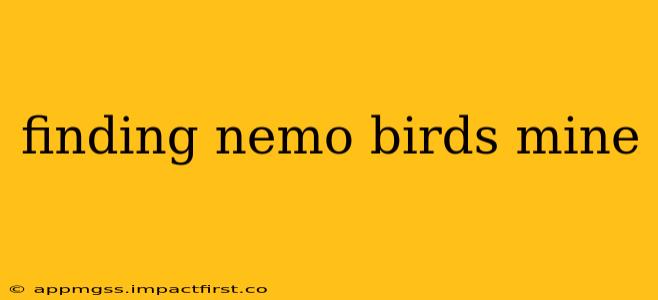Finding Nemo, the beloved Pixar animation, is brimming with memorable characters, many of which are feathered friends. While Nemo and Marlin's journey focuses primarily on the underwater world, the birds play a significant, and often hilarious, role. This post delves into the avian species featured in the film, examining their real-world counterparts and their importance to the narrative.
What Kind of Birds are in Finding Nemo?
The most prominent birds in Finding Nemo are the seagulls, specifically Australian Silver Gulls. These birds are depicted with their characteristic grey and white plumage, often seen scavenging along the coastline. Their behavior in the movie—greedy, opportunistic, and somewhat clumsy—is a playful exaggeration of their real-world tendencies. They’re not directly involved in the main plot but provide comedic relief and represent the external threats lurking outside the reef’s protective embrace.
Beyond the seagulls, we encounter the pelicans, notably the Australian Pelican. These majestic birds are portrayed with a more ambivalent character. They're initially perceived as a threat, but their leader, Nigel, eventually plays a crucial albeit somewhat unintentional role in helping Marlin and Dory. Their large size and distinctive pouch add to the visual appeal of the film, while their presence subtly hints at the vastness and interconnectedness of the ocean ecosystem.
Are the Birds in Finding Nemo Based on Real Birds?
Yes, absolutely! Pixar meticulously researched the species depicted in Finding Nemo, drawing inspiration from real-world counterparts. While artistic liberties were taken to enhance the comedic aspects and visual storytelling, the seagulls and pelicans are clearly based on the Australian Silver Gull and the Australian Pelican respectively. This attention to detail contributes to the film's overall realism and immersive quality. The animators didn't create fantastical birds; instead, they skillfully used familiar species to enhance the narrative and comedic elements.
What Role Do the Birds Play in the Movie?
The birds' role in Finding Nemo extends beyond mere background characters. They serve several important functions:
- Comic Relief: The seagulls' antics, particularly their squabbling and clumsy attempts to steal food, inject humor into the narrative, offering a lighter counterpoint to the more serious aspects of Marlin's journey.
- Symbolic Representation of External Threats: The birds represent the dangers that lurk outside the seemingly safe environment of the coral reef, reminding the audience of the larger, unpredictable world beyond.
- Plot Advancement (Unintentionally): Nigel, the pelican, unintentionally aids Marlin and Dory in their quest to find Nemo, illustrating the unpredictable nature of chance encounters and highlighting the interconnectedness of the marine and avian worlds.
What are the Names of the Birds in Finding Nemo?
While the seagulls don't have individual names, the pelican leader is named Nigel. He is the central character among the pelican flock, and his somewhat grumpy but ultimately helpful personality contributes to the storyline's comedic and narrative arcs.
How Accurate is the Depiction of Birds in Finding Nemo?
The depiction of birds in Finding Nemo is reasonably accurate in terms of species identification and general behavior. However, certain elements are exaggerated for comedic effect. For instance, the seagulls' greed and clumsiness are amplified for humorous purposes. Similarly, while pelicans are known to gather in groups, the synchronized movements of the pelican flock might be a stylistic choice for visual appeal rather than an entirely realistic portrayal of their collective behavior.
In conclusion, the birds in Finding Nemo are more than just pretty additions to the background; they’re integral to the film's narrative, comedic timing, and overall success. By basing them on real-world species, Pixar not only enhanced the film's realism but also deepened the audience's appreciation for the diverse inhabitants of the marine and coastal ecosystems.
